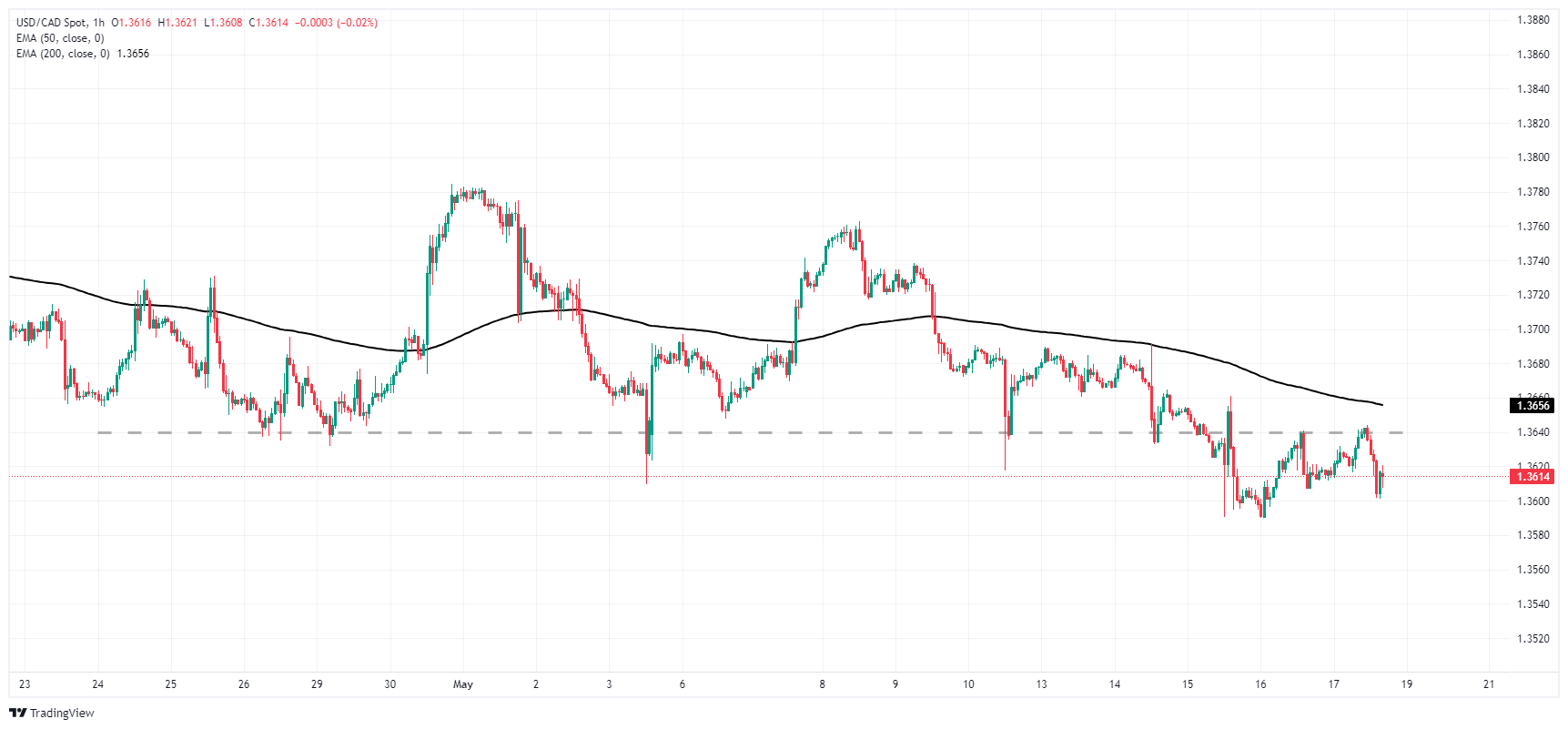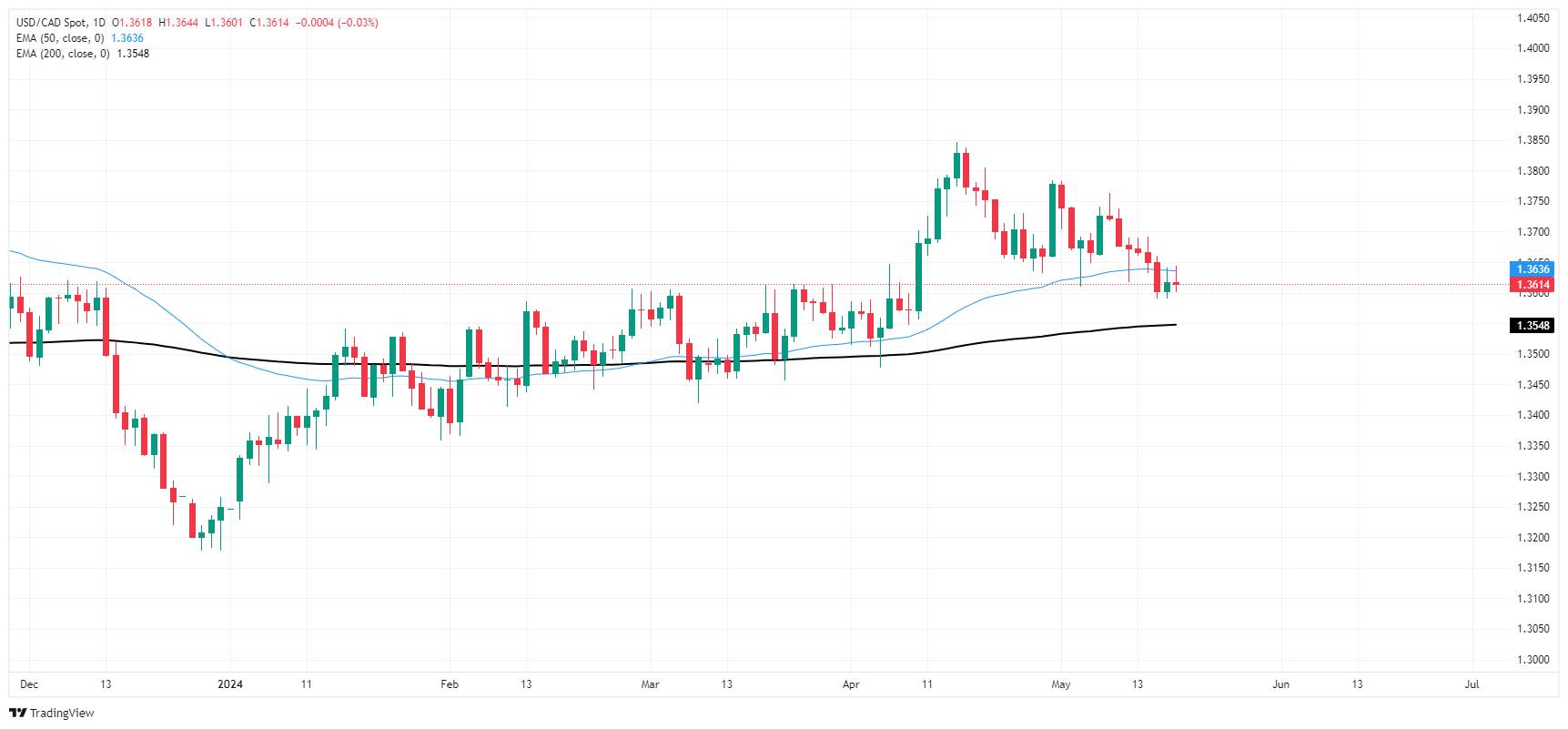- Analytics
- News and Tools
- Market News
- Canadian Dollar sticks to the middle on tepid Friday
Canadian Dollar sticks to the middle on tepid Friday
- Canadian Dollar taking a breather amidst easy Friday markets.
- Canada is set for a long weekend and will return on Tuesday with CPI inflation.
- Fedspeak to dominate as investors await signs of Fed rate cuts.
The Canadian Dollar (CAD) is trading softly on a low-volatility Friday, sticking close to the midrange. CAD traders are geared up to knock off for a long weekend, and markets are treading water after a hectic week that saw broader markets kick up rate cut expectations from the Federal Reserve (Fed) after US Consumer Price Index (CPI) inflation growth eased to a three-month low in April.
Canada is set to release its latest CPI inflation update next Tuesday, and Canadian institutions will be shuttered on Monday in observance of Victoria Day. Fedspeak is set to continue dominating headlines as markets look for signs of rate cuts in the face of easing inflation figures that continue to drift toward the Fed’s 2% target range.
Daily digest market movers: Canadian Dollar close to flat as markets ease into weekend mode
- Foreign Portfolio Investment in Canada rose $14.37 billion in March, well above the forecast of $3.51 billion and scrubbing out the previous month’s $-4.28 billion decline, which was revised upwards from $-8.78 billion.
- US CPI inflation cooled this week, tipping markets further into rate cut hopes.
- CME’s FedWatch Tool shows rate traders are pricing in nearly 70% odds of at least a quarter-point cut in September.
- Next week brings a slew of appearances from Fed officials as policymakers from the US central bank head to the Financial Markets Conference hosted by the Federal Reserve Bank of Atlanta.
- Federal Open Market Committee’s (FOMC) latest Meeting Minutes will be released next week, and investors will be looking out for any signs of overly dovish language from Fed deliberations.
Canadian Dollar PRICE Today
The table below shows the percentage change of Canadian Dollar (CAD) against listed major currencies today. Canadian Dollar was the strongest against the Swiss Franc.
| USD | EUR | GBP | JPY | CAD | AUD | NZD | CHF | |
|---|---|---|---|---|---|---|---|---|
| USD | -0.05% | -0.30% | 0.12% | -0.07% | -0.21% | -0.23% | 0.16% | |
| EUR | 0.05% | -0.25% | 0.19% | -0.01% | -0.13% | -0.16% | 0.22% | |
| GBP | 0.30% | 0.25% | 0.44% | 0.26% | 0.12% | 0.08% | 0.46% | |
| JPY | -0.12% | -0.19% | -0.44% | -0.21% | -0.33% | -0.37% | 0.04% | |
| CAD | 0.07% | 0.00% | -0.26% | 0.21% | -0.13% | -0.15% | 0.24% | |
| AUD | 0.21% | 0.13% | -0.12% | 0.33% | 0.13% | -0.03% | 0.35% | |
| NZD | 0.23% | 0.16% | -0.08% | 0.37% | 0.15% | 0.03% | 0.41% | |
| CHF | -0.16% | -0.22% | -0.46% | -0.04% | -0.24% | -0.35% | -0.41% |
The heat map shows percentage changes of major currencies against each other. The base currency is picked from the left column, while the quote currency is picked from the top row. For example, if you pick the Canadian Dollar from the left column and move along the horizontal line to the US Dollar, the percentage change displayed in the box will represent CAD (base)/USD (quote).
Technical analysis: Canadian Dollar middles on quiet Friday session
The Canadian Dollar (CAD) is treading water in familiar territory on Friday, trading within a quarter of a percent across the board. The CAD has gained around a quarter of a percent against the Swiss Franc (CHF) and is down around a quarter of a percent against the Pound Sterling (GBP).
USD/CAD is bidding firmly within recent technical levels with intraday trading stuck to a familiar support and resistance level at 1.3640. Price action remains pinned on the low side of the 200-hour Exponential Moving Average (EMA) at 1.364.
USD/CAD hourly chart
USD/CAD daily chart
Canadian Dollar FAQs
The key factors driving the Canadian Dollar (CAD) are the level of interest rates set by the Bank of Canada (BoC), the price of Oil, Canada’s largest export, the health of its economy, inflation and the Trade Balance, which is the difference between the value of Canada’s exports versus its imports. Other factors include market sentiment – whether investors are taking on more risky assets (risk-on) or seeking safe-havens (risk-off) – with risk-on being CAD-positive. As its largest trading partner, the health of the US economy is also a key factor influencing the Canadian Dollar.
The Bank of Canada (BoC) has a significant influence on the Canadian Dollar by setting the level of interest rates that banks can lend to one another. This influences the level of interest rates for everyone. The main goal of the BoC is to maintain inflation at 1-3% by adjusting interest rates up or down. Relatively higher interest rates tend to be positive for the CAD. The Bank of Canada can also use quantitative easing and tightening to influence credit conditions, with the former CAD-negative and the latter CAD-positive.
The price of Oil is a key factor impacting the value of the Canadian Dollar. Petroleum is Canada’s biggest export, so Oil price tends to have an immediate impact on the CAD value. Generally, if Oil price rises CAD also goes up, as aggregate demand for the currency increases. The opposite is the case if the price of Oil falls. Higher Oil prices also tend to result in a greater likelihood of a positive Trade Balance, which is also supportive of the CAD.
While inflation had always traditionally been thought of as a negative factor for a currency since it lowers the value of money, the opposite has actually been the case in modern times with the relaxation of cross-border capital controls. Higher inflation tends to lead central banks to put up interest rates which attracts more capital inflows from global investors seeking a lucrative place to keep their money. This increases demand for the local currency, which in Canada’s case is the Canadian Dollar.
Macroeconomic data releases gauge the health of the economy and can have an impact on the Canadian Dollar. Indicators such as GDP, Manufacturing and Services PMIs, employment, and consumer sentiment surveys can all influence the direction of the CAD. A strong economy is good for the Canadian Dollar. Not only does it attract more foreign investment but it may encourage the Bank of Canada to put up interest rates, leading to a stronger currency. If economic data is weak, however, the CAD is likely to fall.
© 2000-2024. Уcі права захищені.
Cайт знаходитьcя під керуванням TeleTrade DJ. LLC 2351 LLC 2022 (Euro House, Richmond Hill Road, Kingstown, VC0100, St. Vincent and the Grenadines).
Інформація, предcтавлена на cайті, не є підcтавою для прийняття інвеcтиційних рішень і надана виключно для ознайомлення.
Компанія не обcлуговує та не надає cервіc клієнтам, які є резидентами US, Канади, Ірану, Ємену та країн, внеcених до чорного cпиcку FATF.
Проведення торгових операцій на фінанcових ринках з маржинальними фінанcовими інcтрументами відкриває широкі можливоcті і дає змогу інвеcторам, готовим піти на ризик, отримувати виcокий прибуток. Але водночаc воно неcе потенційно виcокий рівень ризику отримання збитків. Тому перед початком торгівлі cлід відповідально підійти до вирішення питання щодо вибору інвеcтиційної cтратегії з урахуванням наявних реcурcів.
Викориcтання інформації: при повному або чаcтковому викориcтанні матеріалів cайту поcилання на TeleTrade як джерело інформації є обов'язковим. Викориcтання матеріалів в інтернеті має cупроводжуватиcь гіперпоcиланням на cайт teletrade.org. Автоматичний імпорт матеріалів та інформації із cайту заборонено.
З уcіх питань звертайтеcь за адреcою pr@teletrade.global.















